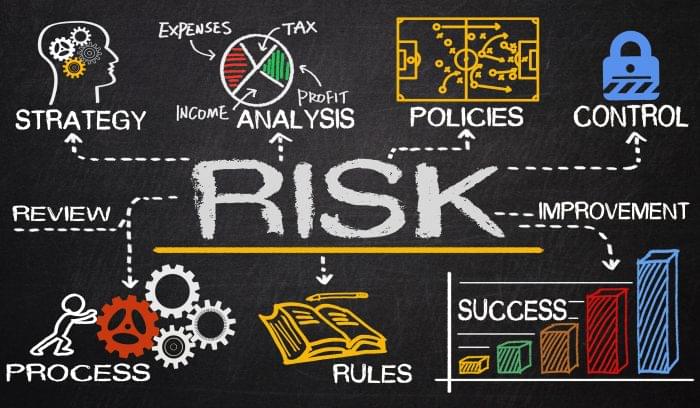Construction projects will always carry some risk, but it’s the project manager’s duty to minimize and manage the scope of that risk. Let’s look at an example:
Stakeholders who had to approve a critical design sign-off were on holiday during the Thanksgiving weekend, which led to a slippage of a scheduled design stage milestone. Two weeks later, the project manager brags to his customer that he still made up for the delayed milestone by requesting his team to work overtime on the design deliverables.
The action by the project manager is a clear example of poor risk management on a project that affects the deliverable and possibly brand reputation.
To better understand what this project manager could have done differently, we’ll examine what risks are and how they are different from issues, why risk management is essential to projects, and typical steps in managing risks on a construction project.
Jump to:
- What is a risk?
- Why is risk management critical in construction projects?
- Risk management guidelines
- Early identification and ongoing attention leads to maximum risk management
What is a risk?
Risks are possible future events that may or may not occur. If they happen, they can negatively or positively impact the project. Negative risks are threats like scheduling a critical sign-off around a holiday season, affecting the project if stakeholders are unavailable. Positive risks are opportunities. In our example, while scheduling the project, the manager missed analyzing risks (a future possibility) that may impact the project outcomes, and put undue pressure on employees.
If a project manager looks at a big picture of the volume of product procurement for 3 of his ongoing projects, he may decide to make a bulk purchase to get products at significant discounts. His goal is to utilize the opportunity for accruing a benefit either for the project or for the organization through extra discounts or increased backlog, taking advantage of a positive risk.
Another manager is testing the fire suppression system in an ongoing project, and gets the pressure settings incorrect. Due to erroneous pressure, the water bulbs burst and caused damage to the installed furniture and carpets. While no one planned for this issue, the next step can only be taking action.
Why is risk management critical in construction projects?
Risk management helps maximize the probability of project success by maximizing opportunities and minimizing the devastating impacts of threats. But this alone doesn’t complete the importance of risk management. If a risk triggers on a project, it may impact one or several other facets of the project like delaying the schedule, skewing resource deployment, leading to last-minute changes, and leaving the customer dissatisfied. Further, some risk mitigation measures may require careful planning in advance, especially those that interact with costs and procurement.
For instance, consider a large commercial project in one of the growing business districts where the central power infrastructure is still under implementation. The State Government is undertaking the commission and anticipates involving many statutory approvals and laying underground cables along a high traffic highway. The project manager expects this as one of the critical project risks that may impact the timely operation of the premises. Because of the expected delays, he advises the customer to hold back a contingency for leasing generators if the power infrastructure gets delayed.
If contingencies like this are unplanned in advance, it may jeopardize projects due to a lack of funds. A common example of risk’s close association with procurement is the insurance clause incorporated in the agreement while purchasing goods and services to make up for damages/losses during transit.
Also Read: Best Procurement & Purchasing Software 2021
Risk management guidelines
Who identifies project risks and when are they identified?
Risk identification starts as early as the project planning starts, which allows the whole team ample time to plan for the expected issues. Risk identification is a team effort. While the project manager can steer this effort, the entire stakeholders and the project team participate because everyone’s perception of risk is different. Using risk management software can help with this.
Once the team identifies risks, these get tabulated in a risk register. Many construction project management software platforms will include a risk register as part of the software so the team has a central place to document the risks. But the risk identification efforts don’t end here. The risk register is a live document reviewed periodically to implement mitigation strategies for high priority risks and keep an eye for new risks that may emerge.
On large projects, the risk register may include many risks. Analytical techniques, primarily qualitative analysis that multiply the probability of risk occurrence with its impact, helps prioritize risks. Teams can generate heat maps to visualize the most critical ones. When a risk occurrence throws up a range of possible outcomes, teams can use quantitative analysis techniques, which use computer simulation models to find a result for a range of possible inputs.
A project manager periodically monitors mitigation measures for planned risks. Planning allows the project manager to initiate a response to potential risks based on the timing of when they could arise, allowing risk management efforts to get communicated to all the stakeholders impacted by the risk.
Early identification and ongoing attention leads to maximum risk management
Risk can be predictable, and mitigation measures can be well planned; construction projects can significantly succeed by early risk planning, identification, response implementation, and continuous monitoring. By integrating risk management to permeate with all other facets of project management, construction project managers can deliver projects successfully.
Read Next: Use Project Management for Smooth Organizational Change

